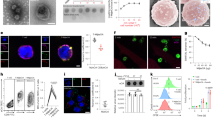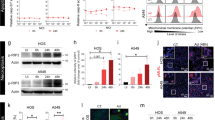Abstract
Recent evidence has resurrected the concept of specialized populations of T lymphocytes that are able to suppress an antigen-specific immune response. T-regulatory cells (T-reg) have been characterized as CD4+ CD25+ T cells. Previous reports describing differential gene expression analysis have shown that the glucocorticoid-induced tumor necrosis family receptor family-related gene (GITR) is upregulated in these cells. Furthermore, antibodies specific for GITR have been shown to inhibit the T-suppressor function of CD4+ CD25+ T-reg. The ligands for both mouse and human GITR have been cloned recently. We have inserted the sequences for natural, membrane-bound GITR-ligand (GITR-L) and a truncated secreted form of GITR-L (GITR-Lsol) into the adenovirus-5 genome. Coculture experiments show that cells infected with Ad-GITR-L and supernatants from cells infected with Ad-GITR-Lsol can increase the proliferation of both CD4+ CD25- and CD8+ T cells in response to anti-CD3 stimulation, in the presence, as well as in the absence, of CD4+ CD25+ T cells. The virus constructs were injected into growing B16 melanoma tumors. Ad-GITR-L was shown to attract infiltration with both CD4+ and CD8+ T cells. Both constructs were shown to inhibit tumor growth.
This is a preview of subscription content, access via your institution
Access options
Subscribe to this journal
Receive 12 print issues and online access
$259.00 per year
only $21.58 per issue
Buy this article
- Purchase on Springer Link
- Instant access to full article PDF
Prices may be subject to local taxes which are calculated during checkout






Similar content being viewed by others
References
Ades EW, Bosse D, Orr S, Gillespie T . Immune responses in humans while receiving adoptive immunotherapy with recombinant interleukin-2 and lymphokine-activated killer cells: acute anergy to mitogens and recall antigens. Pathobiology. 1990;58:78–83.
Wolf AM, Wolf D, Steurer M, Gastl G, Gunsilius E, Grubeck-Loebenstein B . Increase of regulatory T cells in the peripheral blood of cancer patients. Clin Cancer Res. 2003;9:606–612.
Gershon RK, Kondo K . Cell interactions in the induction of tolerance: the role of thymic lymphocytes. Immunology. 1970;18:723–737.
Dietz MH, Sy MS, Benacerraf B, Nisonoff A, Greene MI, Germain RN . Antigen- and receptor-driven regulatory mechanisms. VII. H-2-restricted anti-idiotypic suppressor factor from efferent suppressor T cells. J Exp Med. 1981;153:450–463.
Ptak W, Bereta M, Ptak M, Gershon RK, Green DR . Antigen-specific T contrasuppressor factor in cell-mediated immunity: interactions leading to eradication of the tolerant state. J Immunol. 1984;133:1124–1130.
Tanaka H, Tanaka J, Kjaergaard J, Shu S . Depletion of CD4+ CD25+ regulatory cells augments the generation of specific immune T cells in tumor-draining lymph nodes. J Immunother. 2002;25:207–217.
Ghiringhelli F, Larmonier N, Schmitt E, et al. CD4+CD25+ regulatory T cells suppress tumor immunity but are sensitive to cyclophosphamide which allows immunotherapy of established tumors to be curative. Eur J Immunol. 2004;34:336–344.
McHugh RS, Whitters MJ, Piccirillo CA, et al. CD4(+)CD25(+) immunoregulatory T cells: gene expression analysis reveals a functional role for the glucocorticoid-induced TNF receptor. Immunity. 2002;16:311–323.
Shimizu J, Yamazaki S, Takahashi T, Ishida Y, Sakaguchi S . Stimulation of CD25(+)CD4(+) regulatory T cells through GITR breaks immunological self-tolerance. Nat Immunol. 2002;3:135–142.
Ronchetti S, Zollo O, Bruscoli S, et al. GITR, a member of the TNF receptor superfamily, is costimulatory to mouse T lymphocyte subpopulations. Eur J Immunol. 2004;34:613–622.
Ronchetti S, Nocentini G, Riccardi C, Pandolfi PP . Role of GITR in activation response of T lymphocytes. Blood. 2002;100:350–352.
Ji HB, Liao G, Faubion WA, et al. Cutting edge: the natural ligand for glucocorticoid-induced TNF receptor-related protein abrogates regulatory T cell suppression. J Immunol. 2004;172:5823–5827.
Sutmuller RP, van Duivenvoorde LM, van Elsas A, et al. Synergism of cytotoxic T lymphocyte-associated antigen 4 blockade and depletion of CD25(+) regulatory T cells in antitumor therapy reveals alternative pathways for suppression of autoreactive cytotoxic T lymphocyte responses. J Exp Med. 2001;194:823–832.
Erbs P, Regulier E, Kintz J, et al. In vivo cancer gene therapy by adenovirus-mediated transfer of a bifunctional yeast cytosine deaminase/uracil phosphoribosyltransferase fusion gene. Cancer Res. 2000;60:3813–3822.
Chartier C, Degryse E, Gantzer M, Dieterle A, Pavirani A, Mehtali M . Efficient generation of recombinant adenovirus vectors by homologous recombination in Escherichia coli. J Virol. 1996;70:4805–4810.
Fallaux FJ, Bout A, van der Velde I, et al. New helper cells and matched early region 1-deleted adenovirus vectors prevent generation of replication-competent adenoviruses. Hum Gene Ther. 1998;9:1909–1917.
Roopenian DC, Widmer MB, Orosz CG, Bach FH . Helper cell-independent cytolytic T lymphocytes specific for a minor histocompatibility antigen. J Immunol. 1983;130:542–545.
Berd D, Maguire, Mastrangelo MJ . Impairment of concanavalin A-inducible suppressor activity following administration of cyclophosphamide to patients with advanced cancer. Cancer Res. 1984;44:1275–1280.
Berd D, Sato T, Maguire Jr HC, Kairys J, Mastrangelo MJ . Immunopharmacologic analysis of an autologous, hapten-modified human melanoma vaccine. J Clin Oncol. 2004;22:403–415.
Miles DW, Towlson KE, Graham R, et al. A randomised phase II study of sialyl-Tn and DETOX-B adjuvant with or without cyclophosphamide pretreatment for the active specific immunotherapy of breast cancer. Br J Cancer. 1996;74:1292–1296.
Phan GQ, Yang JC, Sherry RM, et al. Cancer regression and autoimmunity induced by cytotoxic T lymphocyte-associated antigen 4 blockade in patients with metastatic melanoma. Proc Natl Acad Sci USA. 2003;100:8372–8377.
Author information
Authors and Affiliations
Corresponding author
Rights and permissions
About this article
Cite this article
Calmels, B., Paul, S., Futin, N. et al. Bypassing tumor-associated immune suppression with recombinant adenovirus constructs expressing membrane bound or secreted GITR-L. Cancer Gene Ther 12, 198–205 (2005). https://doi.org/10.1038/sj.cgt.7700781
Received:
Published:
Issue Date:
DOI: https://doi.org/10.1038/sj.cgt.7700781
Keywords
This article is cited by
-
Prospects for combined use of oncolytic viruses and CAR T-cells
Journal for ImmunoTherapy of Cancer (2017)
-
Potentiation of immunomodulatory antibody therapy with oncolytic viruses for treatment of cancer
Molecular Therapy - Oncolytics (2014)
-
Glucocorticoid-induced TNFR-related protein (GITR) ligand modulates cytokine release and NK cell reactivity in chronic lymphocytic leukemia (CLL)
Leukemia (2012)
-
Therapeutic Immunity by Adoptive Tumor-primed CD4+ T-cell Transfer in Combination With In Vivo GITR Ligation
Molecular Therapy (2009)
-
The anti-cancer agents lenalidomide and pomalidomide inhibit the proliferation and function of T regulatory cells
Cancer Immunology, Immunotherapy (2009)



